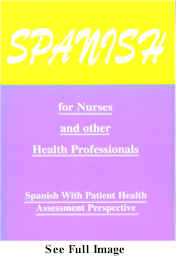 Learning Objectives
Learning Objectives|
Spanish for Nurses and Other Health Professionals |
 Learning Objectives
Learning ObjectivesIntroduction to Spanish
Numbers
Days, Months, Dates Seasons
Clock Time
Adjectives
Estar, Ser
Physical Examination
Admissions Data
Daily Activities
Nutritional Status
Sleep
Hair, Nails and Skin
Head and Neck
Musculoskeletal System
Respiratory System
Cardiovascular System
Gastrointestinal System
Urinary System
Male Reproductive System
Female Breasts
Female Reproductive System
Nervous System
Endocrine System
Immune System and Blood
Dental Conversations
Important Expressions
Vocabulary
|
© 2007 Homestead Schools, Inc. - Webmaster : Shawn J. Cassick |